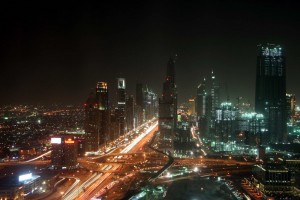By Martina Fuchs and Shaheen Pasha www.reuters.com
A dusty industrial zone in flashy Dubai has become an unlikely home for a flourishing underground art scene that has grown even as the emirate’s fortunes declined, curbing appetites for extravagant pieces.

Al Quoz, home to stark warehouses and a huge cement factory in the shadow of the world’s tallest building, the Burj Khalifa, is a far cry from the glitz and glamour that has come to be associated with Dubai.
“It’s raw. It’s a clean plate that we can work on. This is a growing cultural hub, a warehouse district where the ceilings are high and rents are low,” said Rami Farook, founder of the Traffic gallery, where Emirati, Iranian and Saudi artists show works ranging from graffiti art to blaring video installations.
That’s a far cry from the art scene just a couple of years ago, when upscale galleries hosted champagne-fuelled purchases that reflected big money and status, like the Maseratis and Bentleys cruising along the emirate’s palm-lined streets.
Now, affordability and artistic message seem to carry more weight, and the seemingly underground vibe is drawing in a different crowd.
At Etemad Gallery, a former furniture warehouse in Al Quoz, a beige wax sculpture of a human torso riddled with bullets and shells stands in the shadows. Nearby is a series comparing the iris of the human eye to constellations of dying stars.
“There is a growing confidence in local contemporary artists and also an increase in interest in women artists from the region,” said Rory Miller, director of Middle East and Mediterranean Studies at Kings College in London.
“Following the economic downturn which hit Dubai hard, there is a move, especially among the younger age group, to look to art that is grittier, more relevant and reflective of their own lives and recent experiences.”
Art houses have taken note of shifting local tastes, even as the higher end of the art market sees signs of a rebound on the back of Dubai’s economic recovery.
“We included a lot more younger artists who are more affordable because we want to increase the depth of participation,” said Michael Jeha, managing director of auction house Christie’s Middle East, which recently held a sale focusing on contemporary artists from Saudi Arabia and Iran.
A number of the pieces sold for less than $10,000, Jeha said, with others available for between $2,000 and $3,000.
All of the works in the Traffic gallery priced between $1,000 and $3,000 sold out. “This made me realize that people in Dubai had this passion for the alternative,” said Traffic’s Farook. “This is the niche I am trying to tap into.”
Raj Sehgal, managing director at Credit Suisse Private Banking in the Middle East and Indian Subcontinent, said some of his clients were looking for investments that could deliver future returns.
“A trend that is quite evident among many of our clients in Dubai is that they have started buying street art due to its appreciation value over time,” Sehgal said.
The political and social upheaval sweeping across the Arab role also appears to be playing a role in the renewed interest in more affordable and urban art.
At Art Dubai, the emirate’s annual contemporary art fair, a number of politically-themed pieces were on display, including one painting that portrayed ousted Egyptian president Hosni Mubarak’s using icons from Facebook, the social networking site that played a role in uniting street protesters against him.
“Possessing a piece of art because of a certain name or status is holding little relevance,” said Omer Alvie, creative director at Villa No. 6, which showcases emerging artists from Pakistan and arranges exhibitions of alternative art in Dubai.
“Now collectors are interested in the theme of the piece and what the artist is saying. It’s a record of history.”












